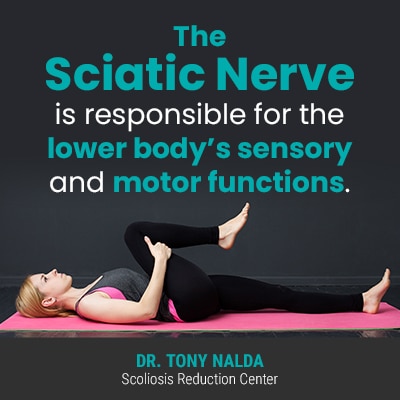A lot of back pain is caused by nerves becoming irritated. When a nerve is exposed to uneven pressure, it can cause pain felt anywhere along its pathway, and as nerves are like branches on a tree, they fan off in multiple directions; this is why sciatic nerve pain is often felt far from the nerve’s site of origin. Keep reading to learn some simple stretches for sciatica pain relief.
The sciatic nerve extends from the lower back, down the buttocks, back of the legs, and into the feet. When the sciatic nerve is compressed, it can cause pain felt anywhere along its pathway. Stretches for sciatica pain relief can help loosen and strengthen the spine and its surrounding muscles.
Before we get into specific stretches for sciatica pain relief, let’s talk about the nature of sciatica, including causes and symptoms.
4 Key Takeaways
- Understanding Sciatica and Its Causes: Sciatica is caused by irritation of the sciatic nerve, with common culprits being herniated discs, bone spurs, and spinal stenosis. Recognizing the root causes is crucial for targeted treatment.
- Identifying Symptoms of Sciatica: Symptoms range from mild ache to a sharp, burning sensation, predominantly radiating from the lower back down through the legs. Early recognition of these signs can lead to more effective management strategies.
- Effective Stretches for Sciatica Relief: Incorporating stretches like the Scissor Hamstring Stretch and Sciatic Nerve Glide into daily routines can significantly alleviate pain by improving flexibility and reducing nerve irritation.
- Comprehensive Approach to Sciatica Treatment: A holistic treatment plan that includes posture correction, physical activity, and professional guidance addresses both symptoms and underlying causes for long-term relief.
The Sciatic Nerve
The sciatic nerve is the largest in the body, originating in the lower back and extending down the buttocks, legs, and into the feet.

The sciatic nerve is responsible for the lower body’s sensory and motor functions.
As the sciatic nerve is both sensory and motor, it helps the lower body with reception, pain, and reflexes, and also facilitates the majority of lower-body functions and actions in the lower limbs: walking, running, climbing, lifting, and standing.
Sciatica
Sciatica refers to radicular pain that’s felt along the sciatic nerve’s path, and most often, this only affects one side of the body.
Sciatica occurs when the sciatic nerve is exposed to uneven pressure, irritating and/or inflaming the nerve, and this can have a number of causes.
Causes of Sciatica
There are many causes of sciatica, but most commonly, sciatica is related to intervertebral disc issues.
The spine is made up of vertebrae (bones) stacked on top of one another in a neutral and straight alignment, and these bones are separated by intervertebral discs.
The discs sit between adjacent vertebrae to provide cushioning, structure, facilitate spinal flexibility, and act as the body’s shock absorbers.
When a disc starts to degenerate and changes shape as a result, it can affect the spine in multiple ways, one of which is by shifting the position of connected vertebrae, and another is when a herniated disc occurs: one of the most common causes of sciatica.
When a disc herniates, this means the disc’s inner gel-like nucleus has pushed its way through a tear in the disc’s tough outer annulus.
When a disc’s interior pushes its way through its outer layer, it protrudes into the spaces within and around the spine, and when a herniated disc occurs in the lower back, it can cause compression of the sciatic nerve.
Other common causes of sciatica include bone spurs and a variety of spinal conditions such as spinal stenosis and scoliosis.
Also called osteophytes, bone spurs are bony projections that develop along a bone’s edges, often where bones meet (in the joints), and when they form on the spinal vertebrae, they can cause a number of issues, sciatica included.
Spinal stenosis is a narrowing of the spaces within the spine, and this can put pressure on the nerves of the spine, most commonly affecting the lower back and neck.
Scoliosis is the development of an unnatural sideways spinal curvature, with rotation, and as scoliosis introduces a lot of uneven forces to the body, it can expose the spine and its surrounding nerves to uneven pressure and compression.
So now that we know some of the most common causes of sciatica, what are its symptoms?
Symptoms of Sciatica
As mentioned, sciatica refers to pain felt along the sciatic nerve’s pathway, so the main symptom is pain.
Depending on the degree of nerve involvement, pain can range from mild and intermittent to chronic and debilitating.

The level of sciatica pain will depend on a number of important patient/condition characteristics such as age, overall health, causation, and the degree of nerve involvement.
As each case is different, sciatica pain is described in different ways:
- Shooting pain
- Electric shock-like pain
- A constant dull ache
- Throbbing/pulsating pain
- Pain that flares up
While sciatica can be felt anywhere along the nerve’s pathway, patients commonly report pain felt in the back or outer edge of the thigh, but can also be felt in these areas:
- Lower back
- Front or back of the thighs
- Front or back of the legs
- Outer or top side of the feet
- In the webbed area between the 1st and 2nd toes
- In the soles of the feet
In the majority of cases, sciatica is more closely associated with leg pain than back pain.
So for people diagnosed with sciatica, are there effective stretches for sciatica pain relief?
3 Simple Stretches for Sciatica Pain Relief
When the lower back, abdomen, and/or hamstring muscles are tight, this can exacerbate sciatica, but these 3 simple stretches for sciatica pain relief can help loosen the spine and its related muscles.
Sciatica stretches can be a valuable tool for relieving sciatic pain, and they are often beneficial for individuals with conditions like scoliosis that can cause sciatica.
These stretches may help alleviate discomfort and improve scoliosis pain relief. For some with both scoliosis and sciatica, the use of inversion tables for scoliosis may complement their treatment plan by reducing pressure on the spine. Additionally, addressing issues like a bulging disc in the neck and back, which can contribute to both scoliosis and sciatic pain, is crucial for comprehensive pain management and overall spinal health.
Sciatica stretches are essential for managing sciatica pain relief, especially for individuals with degenerative disc disease, as they can help alleviate discomfort and improve overall spinal health.
Sciatica stretches, particularly those targeting piriformis syndrome, can provide great relief for sciatica pain by alleviating tension and improving flexibility in the affected muscles.
Incorporating specific sciatica exercises such as the standing hamstring stretch into your routine can be among the best exercises for sciatica pain relief, helping ease sciatica pain and providing much-needed relief.
1) Scissor Hamstring Stretch
The hamstring muscle group consists of three muscles that extend down the back of the thighs from the hip to just past the knees; these muscles facilitate full extension of the leg straight behind the body and the ability to bend the knees.
When the hamstring muscles are tight, there is an excessive pull on the pelvis, and this increases stress on the lower back, potentially irritating the sciatic nerve.
Steps for the Scissor Hamstring Stretch
- Stand with the right foot in front of the left, approximately 3-feet apart.
- Face the hips and shoulders forward, ensuring the left and right hip are aligned.
- Place hands on the hips.
- Bend forward at the waist, hinging the torso forward over the front leg while keeping the back straight and the majority of the body’s weight over the front leg.
- Hold for up to 10 seconds.
- Repeat with the other leg.
Performing daily standing hamstring stretches can help reduce sciatic nerve tension and pain.
2) Sciatic Nerve Glide Exercise
A seated exercise known to help with sciatica pain relief is the sciatic nerve glide which can help by relaxing and desensitizing the sciatic nerve.
When the sciatic nerve is relaxed and desensitized, it’s less likely to become irritated and inflamed.
Steps for the Sciatic Nerve Glide Exercise
- Sit up straight in a chair and straighten one knee. Keep the other foot flat on the floor.
- Slowly bend the ankle in towards the body so the toes are pointing up and back.
- Continue bending the ankle back and forth and the toes away from the body and back in towards the body.
- Pump the ankle up and down 15 to 20 times.
- Repeat with the other leg.
Performing 3 rounds of the sciatic nerve glide exercise for each leg, twice a day, can help keep the sciatic nerve relaxed and less prone to irritation.
3) Back Flexion Stretch
Back flexion stretches involve the spine bending forward and can help increase spinal flexibility, increase abdominal strength, and relieve stiff and tight spinal and abdominal muscles.
Performing a back flexion stretch can help prevent spinal rigidity, muscle stiffness, and related nerve issues such as sciatica.
Steps for the Back Flexion Stretch
- Lie flat on the floor on the back.
- Gently pull the knees up to the chest with both hands until a stretch is felt in the middle and lower back.
- Slowly and gently raise the head forward for an increased stretch.
- Hold the pose for up to 10 seconds.
Performing back flexion stretches with 4 to 6 repetitions daily can help keep the spine and its surrounding muscles as loose and flexible as possible, which can help with sciatica pain relief.
Also read: How To Cure Sciatica Permanently [IS IT POSSIBLE?]
Conclusion
Sciatica stretches are an essential component of any exercise program designed to relieve sciatica pain. These exercises, specifically targeting the sciatic nerve, can help alleviate lower back pain and other sciatica symptoms. Incorporating a structured physical therapy routine that includes sciatic nerve stretches can provide effective relief from sciatica discomfort.
Living with back pain can be highly disruptive to daily life; it can make performing even the simplest of tasks, or getting a good night’s rest, seem impossible.
While there are many different levels of back pain, nerve-related back pain is often considered the most debilitating form.
The sciatic nerve consists of 5 nerve roots fused together in the lumbar spine, which then extend the length of the lower body down the buttocks, legs, and into the feet.
If the sciatic nerve is exposed to uneven pressure and/or compression anywhere along its pathway, the nerve can become inflamed and irritated, causing pain and discomfort to varying degrees.
The main causes of sciatica are intervertebral discs issues such as disc herniation, bone spurs, and a variety of spinal conditions such as spinal stenosis and scoliosis.
When there is a loss of the space in and around the spine, this leaves less room for the nerves to function within, causing irritation and pain.
Here at the Scoliosis Reduction Center®, I’ve treated numerous patients suffering from sciatica; by first determining the underlying cause of the sciatic nerve pain, I can craft a customized treatment plan that addresses key patient/condition characteristics for the best results.





